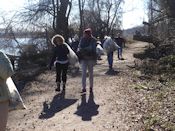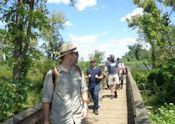
NVCT Volunteers Tackle Ivy and Trash

On the morning of January 18, 2016, the annual Martin Luther King Day of Service and winter’s coldest day so far, 20 hardy volunteers organized by the Northern Virginia Conservation Trust (NVCT) visited the Dyke Marsh Wildlife Preserve. Braving temperatures in the high teens and a brisk wind whipping across the river, the group removed English ivy climbing up trees and collected five bags and a plastic crate of trash.
Hoping to Repopulate Pumpkin Ash Trees

In September 2015, a team from the North Carolina Botanical Garden, working with National Park Service staff and the Friends of Dyke Marsh, collected thousands of pumpkin ash seeds (by the bunch, pictured) from a score of different trees in the preserve. The team has concluded that the seeds are likely viable and in early 2016, they are drying them for long-term storage.
Chesapeake Bay Journal Features Dyke Marsh Restoration

The November 30 Chesapeake Bay Journal includes an article by Whitney Pipkin on the Dyke Marsh restoration project, its need, history and near-term schedule. Thank you, Chesapeake Bay Journal.
Nature's Exquisite Timing

Among many other accomplishments, Henry David Thoreau and Thomas Jefferson were diligent phenologists. They kept detailed journals in which they recorded the timing of events in nature -- when trees leafed out, when flowers bloomed, when the ground was warm enough to plant.
The Sounds of Dyke Marsh

FODMer Laura Sebastianelli lives on the edge of the western part of the Dyke Marsh Wildlife Preserve, the 26 acres west of the George Washington Memorial Parkway, a place she describes as "rich with natural sounds."
Laura admits to a “natural bias,” meaning she loves the sound of nature. She wrote, "Now technically nature includes us humans, but I confess my bias is for birds, insects, frogs, toads, mammals, gentle wind blowing through treetop leaves and water lapping at shoreline edges."
With this playlist, Laura shares some of the wonderful sounds of Dyke Marsh. American bullfrog picture courtesy of Laura Sebastianelli.
FODMers Clean Up Trash

Despite a steady drizzle on November 7, 2015, fourteen FODMers and friends donned their rain gear and cleaned up trash in Dyke Marsh West for almost two hours at low tide. The group collected eight bags of plastic and glass bottles, metal cans, tennis balls, plastic bags, styrofoam, cardboard and more.
Much to See on Fall Colors Walk

It was a nippy, overcast day with temperatures hovering in the low 50s, but the FODMers and friends who turned out for the annual fall colors walk were undaunted. The marsh sported many shades of yellow, orange, red and more and even the plant "skeletons" were interesting, observed FODM walk leader Pat Salamone. The large thorns of the honey locust tree make it a "well-defended" tree, Pat commented (photo).
The DAR Helps in Dyke Marsh

On October 11, 2015, 29 members of the Nelly Custis Chapter and other chapters of the Daughters of the American Revolution (DAR) turned out in force to help in the Dyke Marsh Wildlife Preserve (photo left by Robert Smith). Under FODM Vice-President Ned Stone's direction, they split into three groups and cleaned the shoreline of an island and the Belle Haven picnic area and took on invasive plants on the dogleg portion of the Haul Road trail. The eager group collected around 58 bags of trash. "It makes a difference," wrote FODM Treasurer Robert Smith.
Saving Pumpkin Ash Trees

FODM and the National Park Service (NPS) have undertaken a project to save some of the preserve's pumpkin ash trees (Fraxinus profunda) from the emerald ash borer (EAB) (Agrilus planipennis), an invasive insect that has been documented in Northern Virginia and will kill all species of ash trees, according to U.S. Department of Agriculture experts.
Another Step Toward Restoration

On September 28-29, 2015, National Park Service (NPS) and U.S. Army Corps of Engineers (COE) officials met to begin the design of the restoration of Dyke Marsh under a NPS-COE interagency agreement. Officials estimate the design phase will take at least 12 months.
Reaching Out at Earth Sangha

On September 27, 2015, the Friends of Dyke Marsh had a table offering Dyke Marsh information at Earth Sangha's semi-annual native plant sale held at their garden in Springfield. We participated alongside other groups, including the Friends of Huntley Meadows, the Friends of Accotink Creek and the Arlington Master Naturalists.
Ecological Society of America Visits DMWP
 Dr. Guajardo
Dr. Guajardo
On the lovely, warm, sunny day of August 8, 2015, I led 19 ecology students and professional ecologists and one child for a too-abbreviated visit to the Dyke Marsh Wildlife Preserve (DMWP), as part of the special 100th anniversary meeting of the Ecological Society of America being held at the Baltimore Convention Center.


AlbertHerring-b4cc6b5cfb.jpg)



 Friends of Dyke Marsh, Inc. is a non-profit 501(c)(3) organization.
Friends of Dyke Marsh, Inc. is a non-profit 501(c)(3) organization.